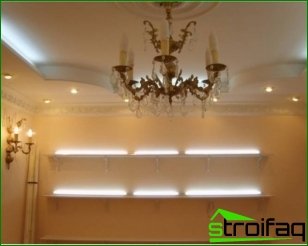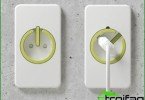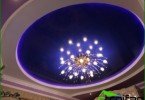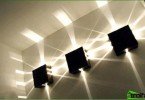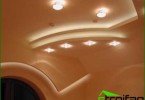Artificial lighting plays an important role in our lives. Our mood and well-being depend on how effectively it is implemented. Let’s look at the various types of artificial lighting.
Varieties of lighting
Lighting may be local, or may be general. General lighting is important for the functioning of the apartment. And local can be further divided into decorative and functional. This group includes light in the vicinity of mirrors, under the kitchen cabinet, above the desk, lighting elements of the room or paintings that we want to highlight. By dividing the lighting into local and general, various types of lamps can be distinguished. They can emit stray light or use directional fluxes..
Features of general lighting
The main kind of artificial lighting is common. By using diffused light, it is possible to penetrate everywhere. This can be achieved with the help of classic chandeliers, luminous balls or hanging lampshades. However, it is important to understand that several reflectors located on a rack do not allow achieving the same effect. And halogen lamps installed in the ceiling will be able to provide the necessary level of lighting only to a fragment of the floor or walls, and the upper part of the room will be in twilight. As a result, the impression is that the lighting is clearly not enough.
However, a conventional lamp will create enough light for the entire space. If you pay enough attention to the ceiling lighting, then the whole room will look spacious. This effect is not allowed to be achieved by plafonds, but for pendant chandeliers this goal is quite attainable..
Many people prefer to use light reflected from the surface of walls and ceilings. The source of such lighting can be fluorescent lamps, thanks to which it is possible to achieve uniform distribution of light. The amount of light they receive is largely dependent on their size. Even long lighting fixtures do not consume large amounts of electricity..
Functional lighting and its benefits
This kind of artificial lighting depends on where it is located, as well as on the place of its implementation. It is important that the lamps located above the table make it possible to obtain diffuse lighting. Most requirements are fulfilled by lamps with a shade that covers the light bulb.
Artificial lighting plays an important role in our lives. Our mood and well-being depend on how effectively it is implemented. Let’s look at the various types of artificial lighting.Varieties of lighting
Lighting may be local, or may be general. General lighting is important for the functioning of the apartment. And local can be further divided into decorative and functional. This group includes light in the vicinity of mirrors, under the kitchen cabinet, above the desk, lighting elements of the room or paintings that we want to highlight. By dividing the lighting into local and general, various types of lamps can be distinguished. They can emit stray light or use directional fluxes..
Features of general lighting
The main kind of artificial lighting is common. By using diffused light, it is possible to penetrate everywhere. This can be achieved with the help of classic chandeliers, luminous balls or hanging lampshades. However, it is important to understand that several reflectors located on a rack do not allow achieving the same effect. And halogen lamps installed in the ceiling will be able to provide the necessary level of lighting only to a fragment of the floor or walls, and the upper part of the room will be in twilight. As a result, the impression is that the lighting is clearly not enough.
However, a conventional lamp will create enough light for the entire space. If you pay enough attention to the ceiling lighting, then the whole room will look spacious. This effect is not allowed to be achieved by plafonds, but for pendant chandeliers this goal is quite attainable..
Many people prefer to use light reflected from the surface of walls and ceilings. The source of such lighting can be fluorescent lamps, thanks to which it is possible to achieve uniform distribution of light. The amount of light they receive is largely dependent on their size. Even long lighting fixtures do not consume large amounts of electricity..
Functional lighting and its benefits
This kind of artificial lighting depends on where it is located, as well as on the place of its implementation. It is important that the lamps located above the table make it possible to obtain diffuse lighting. Most requirements are fulfilled by lamps with a shade that covers the light bulb.
Near the armchair or sofa located against the wall should be located lamps that provide an adequate level of light for reading and become a suitable decoration for the living room. Floor lamps can meet both of these requirements. And the lamps located at the mirror should not dazzle, but provide enough light for the face. To do this, the bulbs must be installed above the mirror in a lowered ceiling or above eye level.
Work surfaces should also be well lit – ironing board, table or kitchen top. The desk should also be lit. Particularly effective in this case is directional lighting with a fairly wide angle of illumination. And the area around the bed can be filled with night light or sconces.
The use of decorative lighting
Photographs and paintings located on the walls can be illuminated with the help of directional lights mounted in the walls or ceiling. These lights must emit directional halogen light. They can be either built into the ceiling or installed on its base, their shapes are also very diverse.
Above the paintings you can install special wall lights. And large wall decorations (for example, murals) and wall decoration can be illuminated using directional beams of light obtained from the same row of directional lights.
Another method of lighting such surfaces is to use a gap in the ceiling. Permanent light sources can be used here. This decision may give the impression that the wall goes endlessly upward, and light enters the room from somewhere outside through a crack. And if the walls have a decorative texture, then their upper illumination can give a particularly good effect.
In this case, chiaroscuro can emphasize the surface pattern. You can illuminate decorative niches with the help of light sources installed in the ceiling. The sides or the back of the niche can be made of glass, behind which you can arrange lighting.
The things on the shelves can be illuminated from the outside, but you can also place a lamp on the shelf. Especially intriguing is the effect of light that penetrates the septum. It can enter through a section of decorative wall or built-in furniture..
Each type of lighting has its own characteristics. Given them, you can choose a suitable light source that will help in achieving your goals.
